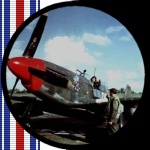The Mighty Eighth
Fightin' Colors
Introduction
Why would a page dedicated to the wartime Luftwaffe feature the US VIII. Air Force?
Although I do not share the popular view that the US almost single handedly defeated Nazi
Germany, I do think it was its AF that was responsible for finally breaking the back of
the Luftwaffe and severely disrupting the German economy's war effort by destroying its
factories and fuel production, the latter causing a rapid decline in the Luftwaffe's
fighting ability by reducing the quality of its replacement crews, by lack of training,
and an ever growing shortage of high grade aviation fuel needed for operations. For this
the Strategic element of the US aerial campaign against the Reich was largely responsible,
the indeed mighty VIII. AF.
The RAF Eagle Squadrons
Like most of my pages the focus will be on the fighter arm, which in case of the VIII. AF,
can find its roots quite some time before the United States officially joined the conflict
in Europe, namely with the American volunteers flying for the Royal Air Force, first
seeing action as a separate unit in the form of No. 71 "Eagle Squadron" on
February 5, 1941, after having been operational since Nov. 1940 flying the Hawker
Hurricane Mk. I; their squadron code being the letters XR, the individual aircraft was
identified by a letter as well, XR-A being the first aircraft in the squadron, followed by
the letter B for the second a/c etc..
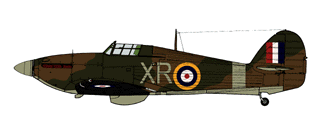
A couple of months
later, May 14, 1941, the second "Eagle Squadron" was formed; identifiable by
their squadron code AV, No. 121 first flew the Hawker Hurricane Mk. IIb into combat near
the end of July 1941.
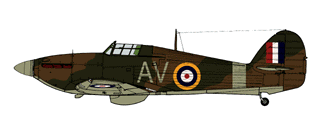
Finally the third and
last of the early "Eagle Squadrons" was formed in the second half of 1941. No.
133 Squadron, code letters MD, first equipped with the Supermarine Spitfire Mk. IIa, began
operations in October 1941.
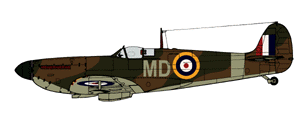
The 4th
Fighter Group
From these three RAF squadrons came the men and machines that would form the first US AAC
Fighter Group in Europe, and the basis of what would become the VIII. AF fighter arm: the
famous 4th FG.
August 22 1942 the 4th Fighter Group was officially constituted and on September 28, the
RAF roundels were exchanged for US markings, No. 71 Sq. became 334 FS, No. 121 Sq. renamed
335 FS, No. 133 Sq. designated 336 FS and its personnel was now officially part of the US
Army Air Corps.
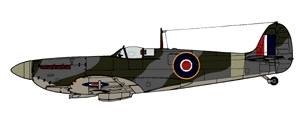
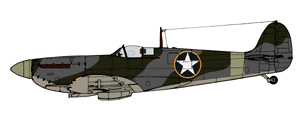
For the rest of 1942
the US fighter pilots would be flying the Spitfire Mk. V, as there wasn't an American
fighter in the numbers and with the performance to take its place. However. this would all
change with the arrival of the first Republic P-47C "Thunderbolt" in January
1943.
The US Spitfires continued to use standard RAF tactical markings and camouflage schemes,
to make the US star insignia more similar to the British roundels, a yellow outline was
adopted to the blue disc. The red dot in the center of the pre- and early war national
insignia had been removed in the 1942, as it was judged too similar to the Japanese
"meat ball"
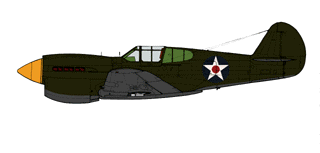
The quick
identification markings (QIM) for these camouflaged fighters were simple and effective;
the forward part of the cowling was painted white, the fin and horizontal stabilizers
received a white line.
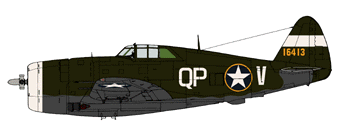
Olive Drab (OD) and
Neutral Grey would be the main camouflage scheme, as the emphasis was only slowly turning
to offensive action, not counting the Circus and Rodeo operations of the 1941-42 period,
which in the end were costly but of little lasting value.
1943 would put the RAF, USAAC and Luftwaffe (at this time still a strong force, maybe even
at its height quality wise) in an epic battle that would end in Allied air superiority
over North-Western Europe in the spring of 1944, the condition needed to start an
Invasion.
It may have been the North American P-51B and D "Mustang" that received all the
attention and acclaim, but it was the Thunderbolt which bore the brunt of the Jagdwaffe's
strength in the west, as it was only in the spring of 1944 that the P-51B began operations
in any numbers, basically after the big battles of 1943 and early '44 and after the battle
of attrition that simply could not be won by the German Jagdwaffe, especially if you
consider the need to divide its resources, in comparison limited, over several fronts,
most notably against the Soviet Union on the infamous Eastern Front.

The yellow outline was
to be replaced by a short lived new marking, which was thought to be more representative
of the US national colors - red, white and blue - but again due to the war in the Pacific,
this was changed in time by replacing the red outline by a blue one. Any US a/c with these
particular red outline national markings can be pinned down to a very specific time period
of June-September 1943.
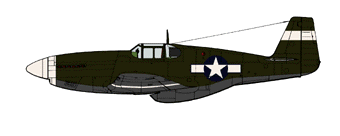
With the arrival of
the P-51 it was decided to add another QIM, a wing stripe, as in the heat of combat the
Mustang bore more then a casual resemblance to late models of the Messerschmitt Bf 109 and
there were many recorded incidents of mistaken identity, even after the additional QIM.
By January 1944 as the Luftwaffe grew steadily weaker and started to remove their more
colorful markings and make their aircraft less conspicuous, the VIII. AF no longer saw the
need for camouflage and subsequently discontinued its use. As the fighters were now
delivered in their natural finish, there was no longer any point in maintaining the low
visibility Group and Squadron markings and these were replaced with some of the most
colorful markings adorned on combat aircraft of any of the WW 2 combatants, as the need
for easy identification was much more important then other possible considerations (due to
an ever increasing superiority in numbers the risk of "friendly fire" was also
growing).
The white QIM were to be replaced by black markings if the a/c was delivered in a white
finish. This has nothing to do with the famous D-Day Invasion stripes.
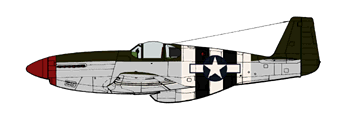
The delivery of new
natural metal a/c did not mean the end of camouflage, many pre-January a/c were still in
use and some units opted to either retain their camouflage or part of it, and between the
two there were many variations, but near the end of the war most fighters in use by the
VIII. AF were natural metal, with the possible exception of the remaining Thunderbolt
fighter units.
Here's a list of the VIII. AF's Fighter Groups, Group markings, Squadrons and Squadron
codes. The schemes shown are basically late 1944, with the possible exception of the 78th
FG. On a later date I will add more schemes on secondary pages, following the individual
Groups from '43 to '45.
| 4th FG "The Eagles" |
 |
| Fighter Squadrons |
Squadron Codes |
Squadron Tails |
|
|
|
- Red
- White w. Black outl.
- Blue
|
| 20th FG |
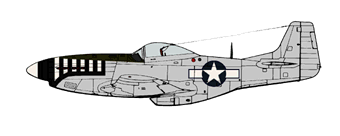 |
| Fighter Squadrons |
Squadron Codes |
Squadron Tails |
|
|
|
- Triangle (w. A/C ID)
- Circle (idem)
- Square (idem)
|
| 55th FG |
 |
| Fighter Squadrons |
Squadron Codes |
Squadron Tails |
- 38th FS
- 338th FS
- 343rd FS
|
|
|
| 56th FG "The Wolfpack" |
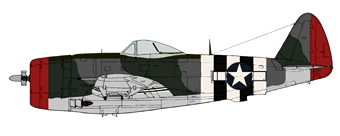 |
| Fighter Squadrons |
Squadron Codes |
Squadron Tails |
|
|
|
|
| 78th FG |
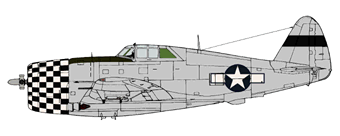 |
| Fighter Squadrons |
Squadron Codes |
Squadron Tails |
|
|
|
- Red
- White w. Red outl.
- Black
|
| 339th FG |
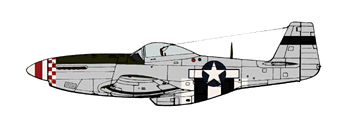 |
| Fighter Squadrons |
Squadron Codes |
Squadron Tails |
- 503rd FS
- 504th FS
- 505th FS
|
|
|
| 352nd FG |
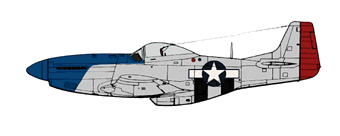 |
| Fighter Squadrons |
Squadron Codes |
Squadron Tails |
- 328th FS
- 486th FS
- 487th FS
|
|
|
| 353rd FG |
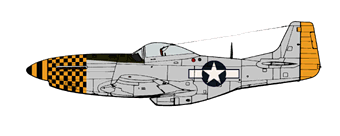 |
| Fighter Squadrons |
Squadron Codes |
Squadron Tails |
- 350th FS
- 351st FS
- 352nd FS
|
|
|
| 354rd FG (officially part of 9th AF!) |
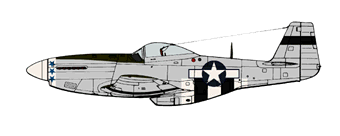 |
| Fighter Squadrons |
Squadron Codes |
Squadron noses (02/45) |
- 353rd FS
- 355th FS
- 356th FS
|
|
|
| 355th FG |
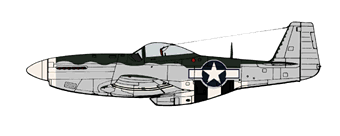 |
| Fighter Squadrons |
Squadron Codes |
Squadron Tails |
- 354th FS
- 357th FS
- 358th FS
|
|
- Red (incl. cowling)
- Blue (idem)
- Yellow (idem)
|
| 356th FG |
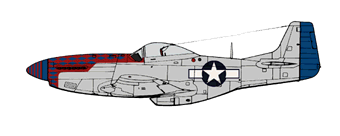 |
| Fighter Squadrons |
Squadron Codes |
Squadron Tails |
- 359th FS
- 360th FS
- 361st FS
|
|
|
| 357th FG |
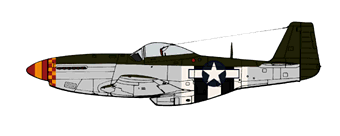 |
| Fighter Squadrons |
Squadron Codes |
Squadron Tails |
- 362nd FS
- 363rd FS
- 364th FS
|
|
|
| 359th FG |
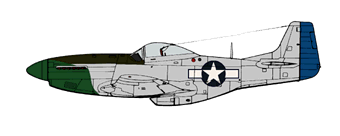 |
| Fighter Squadrons |
Squadron Codes |
Squadron Tails |
- 368th FS
- 369th FS
- 360th FS
|
|
|
| 361st FG |
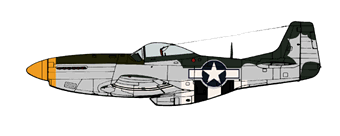 |
| Fighter Squadrons |
Squadron Codes |
Squadron Tails |
- 374th FS
- 375th FS
- 376th FS
|
|
|
| 364th FG |
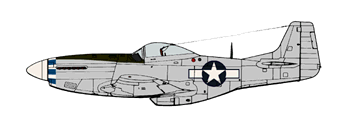 |
| Fighter Squadrons |
Squadron Codes |
Squadron Tails |
- 383rd FS
- 384th FS
- 385th FS
|
|
- Circle (w. A/C ID)
- Square (idem)
- Triangle (idem)
|
| 479th FG "Riddle's Raiders" |
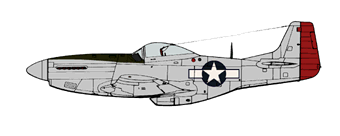 |
| Fighter Squadrons |
Squadron Codes |
Squadron Tails |
- 434th FS
- 435th FS
- 436th FS
|
|
|
* VIII. AF squadron
codes (QP/WD/VF) for these units were never (or seldom) used as the 4th FG would stick to
many RAF traditions for the remainder of W.W.2, like calling their Squadrons 3..3..4 Sq.
instead of 334th, as was the usual practice in the US AAC/F.
The VIII. fighter arm
was structured in a way very similar to that of the Luftwaffe's Jagdwaffe. The following
is a list of their equivalent unit descriptions
| Formation |
US
AAC/F |
RAF |
Luftwaffe |
No.
a/c (US) |
| Administrative |
Wing |
Group |
Geschwader |
5 groups |
| Operational |
Group |
Wing |
Gruppe |
3 squadrons |
| Operational |
Squadron |
Squadron |
Staffel |
16-24-36 a/c |
| Tactical |
Section |
Section |
- |
8 a/c |
| Tactical |
Flight |
Flight |
Schwarm |
4 a/c |
| Tactical |
Element |
- |
Rotte |
2 a/c |
The Section had no
true equivalent in the Luftwaffe, though in practice it would be equal to a Staffel in
combat. A Section was the usual self sustaining unit for bomber escort and support.
Although earlier in the war it was comprised of three flights, a squadron would be
normally devided in two, later even three or four sections.
As the war progressed the total number of aircraft on strength in the squadrons kept
growing until May 1945 when they were more then double the strength of their Luftwaffe
counterparts. A Wing having some 510 aircraft, compared to the nominal maximum
Jagdgeschwader strength of 264 aircraft, a number which in practice a Luftwaffe
Jagdgeschwader rarely achieved, if ever!
The following list shows the VIII. AF Fighter Wings and their respective Groups
| 65th. Fighter Wing |
66th. Fighter Wing |
67th. Fighter Wing |
| 4th. FG |
55th.
FG |
20th.
FG |
| 56th.
FG |
78th.
FG |
352nd.
FG |
| 355th.
FG |
339th.
FG |
356th.
FG |
| 361st.
FG |
353rd.
FG |
359th.
FG |
| 479th.
FG |
357th.
FG |
364th.
FG |
The VIII. AF alone had some 1500+ fighters on strength near the end of their fight against
the Reich and this still leaves the fighters of the 9th and 15th AFs to be added, not even
mentioning the RAF!
Main sources:
Aces of the Eighth
(Special)
Gene Stafford
1973 Squadron/Signal, 63p., SC
ISBN: 0-89747-055-9
Air Force Colors
Volume 2 ETO & MTO 1942-1945
Dana Bell
1995 Squadron/Signal, 96p., SC
ISBN: 0-89747-108-3
Escort to Berlin
The 4th Fighter Group in World War II
Garry Fry & Jeff Ethell
1980 Arco, 226p., HC (Cloth), DJ
ISBN: 0-668-04768-2
Mustang Aces of the Eighth Air Force
Osprey Aircraft of the Aces 1
Jerry Scutts
1995 Osprey, 96p., SC
ISBN: 1-85532-447-4
The Mighty Eighth
A History of the Units, Men and Machines of
the US 8th Air Force
Roger Freeman
1995 Motorbooks, 311p., HC, DJ
ISBN: 0-87938-638-X
|
